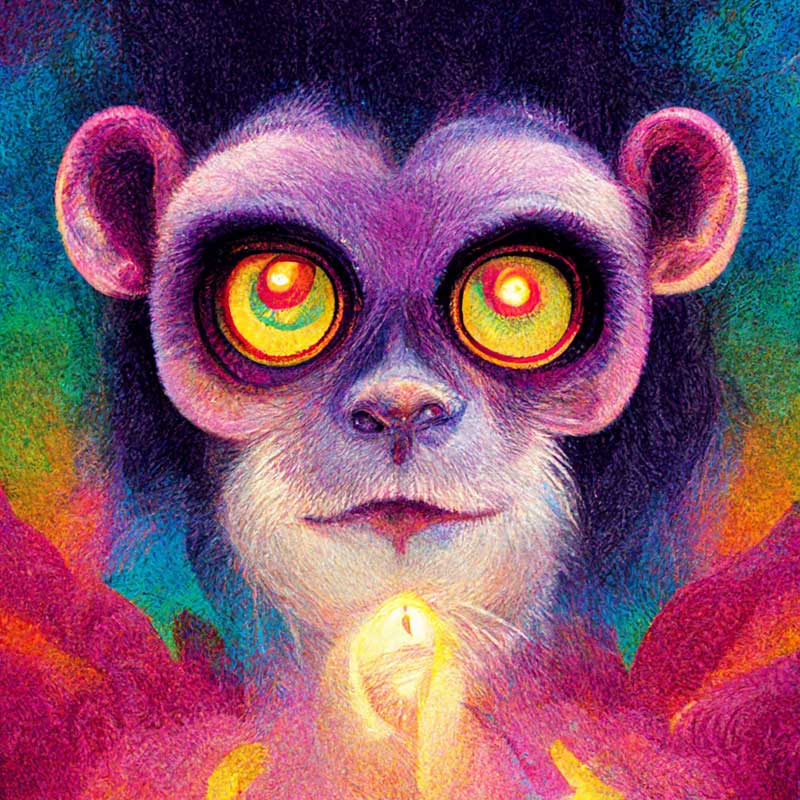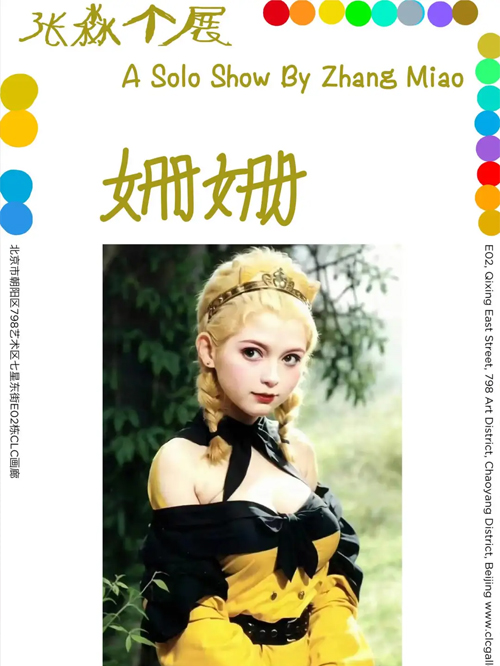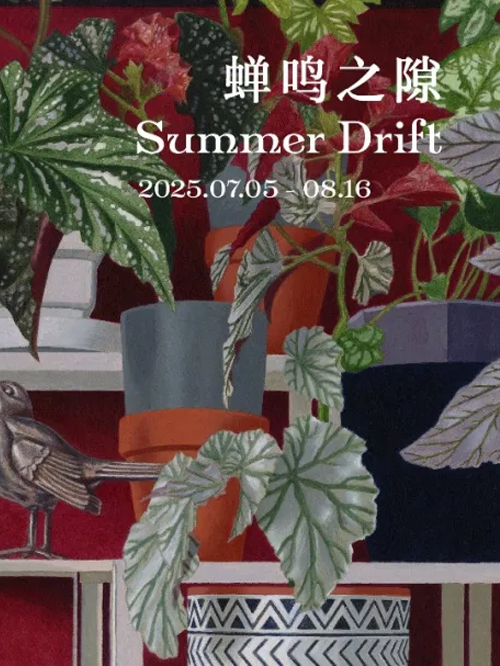展览“姗姗”之中,张淼的创作体现了强烈的流动性。“姗姗”源自中国成语“姗姗来迟”,描摹行动姿态缓慢从容。艺术家以此暗示他的创作是从确定性的视角出逃的轨迹——出逃并非绝决的断裂,却拖沓地建立在既有基础之上,有的时候,两类视角甚至能完成嵌套式的互换。
《进入地库遇见大海》中,浅蓝色似乎要顺延伸向深蓝色,银框的规制却阻碍了隐晦的透视幻觉暗示。张淼以洗练的视觉语言提出这样的观点:艺术的目标并非是操弄视觉惯性,为观众提供乱真的假象;它的效用恰好在于鼓励观众在沉浸其中之后离开画面。在达成这一目标的过程中,颜色起到重要作用。艺术家一方面竭力凸显颜色在光照下微妙运动的意向(他将之称为“without line”),一方面又以粗重的雕塑形态和物质感(他将之称为“with outline”,但他有时候觉得这两个词儿可能是一回事儿)将试图逃逸的色彩圈住。经营此类平衡的工作,他需要在种种心理感受之间辗转调停:远、近、冷、暖、兴奋、沉静。艺术家的创作因而连接成连贯又彼此否定的链条——或者说,一种拧巴的变奏。
在“七个白雪公主和一个小矮人”(2024)、“听不见的看见”(2023)等系列中(又是一些调停的、姗姗的、西西弗斯式的创作案例!),接近于帽子、灯罩或雨伞的形状和接近于人脸或灯座的形状构成了外部环境和心理世界的接壤、混合和关照。张淼认为此类接壤之处是“可居的”,即在放弃了占领确切领域的意愿之后——例如,对某一事件情节叙述的话语权——进入对种种程度精妙调节和干预的自由时空。意识形态化的历史概念决定人的意识与行动框架,这种决定性的关系是富于暴力性的存在。在张淼的实践里,他将不同主体对主体性的争夺的具体关系抽象化,并为艺术实践划定范围,即一种修饰程度的、“副词”性质的艰苦劳作。
伊利莎白·迪勒(Elizabeth Diller)和里卡多•斯卡菲狄欧(Ricardo Scofidio)共创的“慢房”(图一),是展名“姗姗”的由来之一。
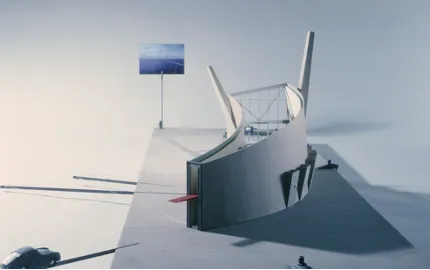
由于建筑的门代替了建筑的正外立面,曲折地通往建筑尽头的海景落地窗,事务所将这所房屋视为入户者“视觉启程的实际入口(a physical entry to an optical departure)。”然而,通过对建筑模型的研究(图二)
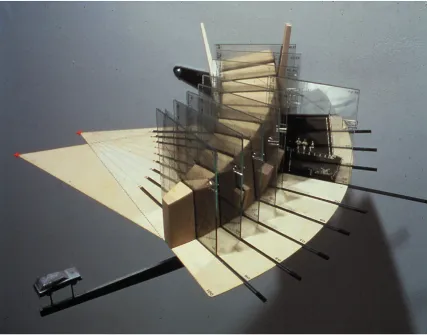
张淼刻意忽略入口处的参观视角,将“慢房”理解为入口侧方两个视点的视野交汇空间的截取和凝固,进而成为盛放身体的“可居”空间。艺术家两幅描摹长颈鹿的画作《姗姗》复刻了目光交叠的空间:当观众移步展厅,闯入两只长颈鹿视角交错所划分的区域,他们不经意间置身最终未能于长岛东部海滨落地的“慢房”内部。
In the exhibition "Lateness" (Chinese title:"Shanshan"), Zhang Miao presents a compelling sense of fluidity in his art practice. Shanshan is drawn from the Chinese idiom, shan shan lai chi, which describes slow and unhurried gesture of movement (a long time coming). With this, the artist suggests his art practice marks a trajectory of escape from a definitive perspective. This escape is not a resolute rupture, but to build on existing foundations in a drawn-out manner. At times, these two types of perspectives could be interchangeable in a nested manner.
In Entering the Basement and Meeting the Sea, the light blue seems to extend to the dark blue, while the silver frame hinders the hint of a hidden perspective illusion. Zhang Miao's sophisticated visual language raises the point that the goal of artistic practice is not to manipulate visual momentum and provide the viewer with a false sense of reality; its function lies precisely in encouraging the viewer to leave the image after being immersed in it. Color plays a vital role in achieving this goal. On the one hand, the artist tries to highlight the subtle movement of color under the light (which he calls "without line"). On the other hand, he uses heavy sculptural forms and materiality (which he calls "with outline," but sometimes thinks these two terms might be the same) to capture the escaping colors. This balancing act requires him to mediate between various psychological senses: distance, proximity, coolness, warmth, excitement, and silence. The artist's practice is thus linked in a chain of coherence and negation - or rather, a twisted variation.
In series such as "Seven Snow White and a Dwarf" (2024) and "The Unhearing Seen" (2023) (again, these are mediating, belated, and Sisyphean works of art!), the closeness in shape between the hat, lampshades or umbrellas and the similarity between faces or lamp stand shape their overlap, blending and mutual projection. Zhang Miao considers such overlaps to be "inhabitable," that is, after relinquishing the will to occupy a precise territory - for example, the discursive power to narrate an event - one obtains the freedom to regulate and intervene to various degrees of subtlety. Historiography under a specific ideology determines the framework of human consciousness and actions, and such a deterministic relationship is rich in violence. In Zhang Miao's practice, he abstracts the specific relationship between the contestation of the subjectivity of various subjects and delimits the scope of artistic practice as an arduous labor of modifying degrees, "adverbial" in nature.
Elizabeth Diller and Ricardo Scofidio's "Slow House" is one of the sources for the exhibition's title, "Lateness ." A door that replaces the front façade of the building and zigzags to a floor-to-ceiling window with an ocean view at the other end of the architecture, the firm considers this house as a "physical entry to an optical departure" for the occupant. However, from studying the architectural model, Zhang Miao deliberately ignores the viewpoint of the entrance and interprets the "Slow House" as the extraction and condensation of the merged spaces seen through the two side viewpoints, hence, it becomes a "livable" space for the body. The artist's two paintings depicting giraffes, "Lateness," reproduce the overlapping spaces. As viewers move through the gallery, they enter the area divided by the two giraffes' intersecting perspectives and inadvertently end up inside the Slow House, which ultimately fails to realize at the waterfront of Long Island's eastern side.
文:杨紫 译:贺潇
by Yang Zi, translated by Fiona He

杨紫,独立策展人,毕业于南京大学哲学系、宗教学系。他于2020年获选为首届“希克中国艺术研究资助计划”研究学人,并担任画廊周北京评委;2019、2021年担任年度华宇青年奖初选评委;2017年入围Hyundai Blue Prize年度艺术大奖;2022年作为访问学者任教于上海科技大学创意与艺术学院。
杨紫具有近十年的艺术评论写作及策展经验,2011年任《艺术界LEAP》杂志编辑,并长期为《艺术界LEAP》、《艺术论坛》中文网和《艺术新闻中文版》等杂志撰写文章。杨紫还曾任UCCA尤伦斯当代艺术中心策展人及公共项目总监,策划多场展览及公共项目活动,包括参与策划了“例外状态:中国境况与艺术考察2017”、“Pity Party”、“敢当:当代神石注疏”、“韶华”、“装饰”、“贮藏(2022)”、“恐怖谷:肉身”等群展,以及诸多艺术家个展。

张淼生于1985年。2008年本科毕业于中央美术学院油画系,2017年硕士毕业于中央美术学院油画系。现在生活工作于北京。
近期展览包括:“姗姗”,CLC画廊,北京,中国,2024;“I Feel The Way You Feel”, 贝浩登上海,中国,2023;“开小差儿”,OCAT西安馆,西安,中国,2022;“Over Arc”,贝尔登博物馆,海牙,荷兰,2022;“HALO”,张淼个展,CLC画廊,北京,中国,2020;“拼拼凑凑的利维坦”,Luhring Augustine,纽约,美国,2019;“It’s Your Moment, Enjoy It”,张淼个展,西五艺术中心,北京,中国,2018;“又又”,张淼个展,C-Space,北京,中国,2016等。作品被中间美术馆、泰康艺术基金、乌里希克等收藏。


